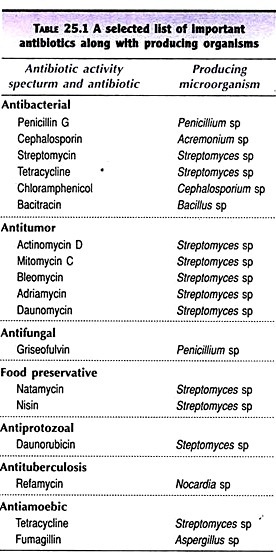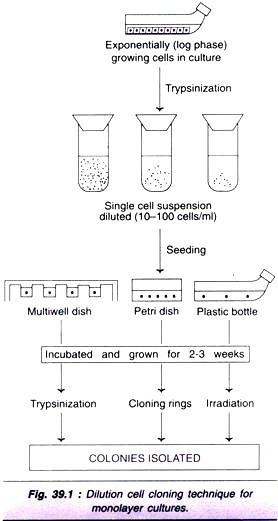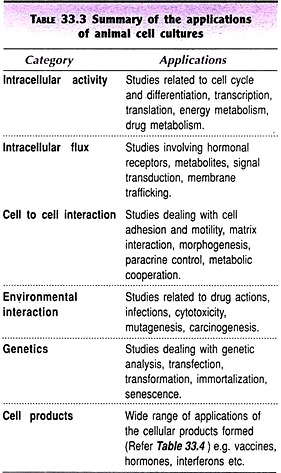ADVERTISEMENTS:
Read this article to learn about the principle of recombinant DNA technology. The principle of recombinant DNA technology involved four steps.
The four steps are: (1) Gene Cloning and Development of Recombinant DNA (2) Transfer of Vector into the Host (3) Selection of Transformed Cells and (4) Transcription and Translation of Inserted Gene.
Knowledge about cell and its functioning has increased to a great magnitude during 20th century. Science and genetics provided basic inputs and now we have gathered information about the structure of master molecule, DNA, its replication and control of gene expression.
ADVERTISEMENTS:
Developments in last three decades were very rapid and gene sequencing, gene cloning and gene transfer in eukaryotes and prokaryotes (and vice versa) have been achieved. This has become possible because genetic code is assumed to be universal.
Genetic engineering may or may not have recombinant DNA (rDNA) preparation step and with the advancement of gene transfer technology, artificially DNA can be transferred to different hosts (host cells) without any vector and host organism can be engineered to carry desired properties. The genetic manipulations are used to produce individuals having a new combination of inherited properties.
Such manipulations may be of two kinds:
(1) Cellular manipulation involving culturing of cells (e.g., haploid cells) and hybridization of somatic cells (protoplast fusion), and
ADVERTISEMENTS:
(2) Molecular manipulation, involving construction of artificial rDNA molecules, their insertion into a vector and their establishment in a host cell or organism.
The latter approach has been called “recombinant DNA (rDNA) technology”. Therefore, use of term “genetic engineering” and “rDNA technology” is overlapping. However, all the manipulations involving use of constructed gene or constructed gene transfer are termed as rDNA technology.
The different steps of recombinant technology include (Fig. 14.7):
a. Gene cloning and development of recombinant DNA:
The foreign DNA (gene of interest) from the source is enzymatically cleaved and ligated (joined) to other DNA molecule i.e. cloning vector (plasmid, phagemid etc.) to form recombinant DNA.
b. Transfer of vector into the host:
This cloning vector with recombinant DNA is transferred into and maintained within a host cell. The introduction of rDNA into a bacterial host cell is called transformation.
c. Selection of transformed cells (host):
Those host cells that take up the rDNA are identified and selected from the pool.
ADVERTISEMENTS:
d. Transcription and translation of inserted gene:
If required, an rDNA construct can be prepared to ensure that the protein product that is encoded by the cloned DNA sequence is produced by the host cell.
1. Gene Cloning and Development of Recombinant DNA:
Any gene to be cloned must be inserted in a cloning vector (plasmid). A foreign gene (DNA fragment) introduced (by transformation) into a bacterium cell will not be replicated with bacterium. The reason for this is that the enzyme DNA polymerase, which is responsible for copying DNA, does not initiate the process at random. It is initiated at selected sites known as “origin of replication”.
ADVERTISEMENTS:
Generally, small fragments of DNA do not possess an origin of replication. Using rDNA technology, it is possible to insert the gene into a ‘cloning vector’, which in turn will make copies of the fragment (inserted DNA). A cloning vector is simply a DNA molecule possessing an ‘origin of replication’ and which can replicate in the host cell of choice. Most commonly ‘plasmids’, extra chromosomal, autonomously replicating, circular DNA molecules, are used as vectors. Sometimes, viruses are used as vector for gene insertion into micro-organisms, but they are better vectors for animal cells.
Cutting and insertion of desired foreign gene into the plasmid require special enzymes known as restriction endonucleases or restriction enzymes. These enzymes cut large DNA molecules into shorter fragments by cleavage at specific nucleotide sequences called ‘recognition sites’. Therefore, restriction endo-nucleases are highly specific deoxy-ribonucleases (DNAse).
Both vector DNA and foreign DNA to be inserted is cut by the same restriction enzyme, generating complementary ends. Thus, ends of foreign DNA make perfect match with cut ends of vector and join to make again a circular molecule. This process can be understood in detail by taking the example of pBR 322 plasmid. It is commonly used cloning vector (Fig. 14.2).
Firstly, purified, closed, circular pBR322 molecules are cut with a restriction enzyme that lies within either of the antibiotic resistance genes and cleaves the plasmid DNA only once to create single, linear, sticky- ended DNA molecules. These linear molecules are combined with prepared target DNA from a source organism. This DNA is cut with the same restriction enzyme, which generates the same sticky ends as those on plasmid DNA. The DNA mixture is treated with T4 ligase in the presence of ATR Under these conditions, a number of different ligated combinations are produced, including the original closed circular plasmid DNA.
ADVERTISEMENTS:
To reduce the amount of this particular unwanted ligation product, the cleaved plasmid DNA preparation is treated with the enzyme alkaline phosphatase to remove the 5′-phosphate groups from the linearized plasmid DNA. Due to this, T4 DNA ligase cannot join the ends of the dephosphorylated linear plasmid DNA.
However, the two phosphodiester bonds that are formed by T4 DNA ligase after the ligation and circularization of alkaline phosphate-treated plasmid DNA with restriction endonuclease digested source DNA (which provides the phosphate groups), are sufficient to hold both molecules together, despite the presence of two nicks (Fig. 14.8). After transformation, these nicks are sealed by the host cell DNA ligase. In addition, fragments from the source DNA are also joined to each other by T4 DNA ligase.
2. Transfer of Vector into the Host:
The next step in a recombinant DNA experiment requires the uptake by E. coli of the rDNA. The process of introducing purified DNA into a bacterial cell is called transformation. This is carried out by treating cells with calcium chloride and high temperature. A few transformed cells are obtained by this method.
ADVERTISEMENTS:
Extra chromosomal DNA that lacks an origin of replication cannot be maintained within a bacterial cell. Thus, uptake of non-plasmid DNA is of no significance in a recombinant DNA experiment. Suitable strain of E. coli is used which lacks capabilities to destroy plasmid DNA or carrying out exchanges between DNA molecules (Fig. 14.9).
3. Selection of Transformed Cells:
After transformation, it is necessary to identify the cells that contain plasmid-cloned DNA constructs. In pBR 322 in which target DNA was inserted onto the BamHI site, recombinant bacteria (bacteria with recombinant plasmid) are selected.
All cells are grown successively on media containing antibiotic, ampicillin or tetracycline and cells showing the recombinant DNA (depending upon the restriction enzyme site and loss of particular antibiotic resistance due to disruption of the gene). Selected recombinant bacteria are grown in bioreactor to obtain the gene product (Fig. 14.10).
ADVERTISEMENTS:
Other methods for selection of recombinant bacteria are:
1. If synthesized gene is used, selection is easy as compared to DNA fragments used from genomic library of an organism, which requires selection for a suitable characters.
2. By nucleic acid hybridization technique.
All the steps are required to be considered carefully in making a recombinant bacterium. Prokaryotic organism E. coli is the most frequently used bacterium for recombinant technology.
4. Transcription and Translation of Inserted Gene:
Transcription of DNA into mRNA is mediated through the enzyme RNA polymerase, which recognizes the binding site on DNA called promoter. The process of mRNA synthesis is terminated by a termination signal (terminator codon). This means, only gene lying between promoter and terminator will be transcribed. Gene isolated in certain ways such as cDNA cloning or artificial synthesis, do not have their own promoter, therefore they must be inserted into a vector close to promoter site.
Even if a cloned gene carries its own promoter, this promoter may not function in the new host cell. In such circumstances, the original promoter has to be replaced. The position of cloned insulin gene with lac promoter in the vector is given in the figure 14.11. This gene is transcribed in presence of lactose because lac operon functions in presence of lactose and transcribe the gene attached downstream to attach it. Similarly, positions of ribosome binding site (rbs) and termination codon are shown in the figure 14.11 in respect to the insulin gene in the vector.
In the cell, transcription takes place inside the nucleus or close to the nucleoid in bacteria by the action of the RNA polymerase on DNA. This process can also be mimicked outside the cell, i.e. cloned DNA can be mixed with RNA polymerase and the four nucleotide in a tube and under appropriate conditions, RNA transcripts can be formed as it does inside the cell. This is known as in vitro transcription. The cellular RNA polymerase, whether it is bacterial or from higher organisms, is an extremely complicated enzyme, containing several subunits.
It is very difficult to purify in an active form. On the other hand, several bacteriophages encode their own RNA polymerases, which are much simpler enzymes, are easy to purify and transcribe genes at a high efficiency. This is because they have evolved to only recognize rate. This phenomenon has been utilized in designing in vitro transcription systems.
The bacteriophage RNA polymerases commonly used for this purpose include those from bacteriophage T3 and T7 which infect E. coli and SP6, which infects Salmonella typhimurim. The promoter sequences recognized by each of these RNA polymerases are different, but can be as small as 21bp in length. Thus, these promoters are designed to be part of the special cloning for in vitro transcription, just upstream of the cloning sites for the DNA fragments to be transcribed.
The cloned DNA, placed downstream of the above promoters, is then incubated with the purified RNA polymerase from the bacteriophage, along with the precursor ribonucleotide triphosphate, which synthesizes transcripts specific for the cloned DNA.
ADVERTISEMENTS:
In vitro derived transcripts are used extensively as probes for the detection of specific nucleic acid fragments both in Southern as well as in Northern hybridization.
Translation:
Translation of mRNA into proteins is a complex process which involves interaction of the mRNA with the ribosomes. For translation to take place the mRNA must carry a ribosome binding site in front (upstream) of the gene to be translated. Ribosome binds to this site and move along the mRNA and initiates protein synthesis at the first AUG codon, it encounters.
This process is stopped by stop codon (UAA, UAG, UGA). In case the cloned gene lacks a rbs, then it is necessary to use a vector with promoter and rbs and the gene is inserted downstream to both these (promoter and rbs).
Translation in a cell is carried out by the ribosomes, which synthesize polypeptides by decoding the information carried by mRNA. In addition, amino-acyl tRNAs and other proteinaceous accessory factors are also utilized. Biochemically the process of translation is not yet fully characterized, which means that we do not know all the requirements for polypeptide synthesis and very few of the components required for the process of translation have actually been purified.
Despite having the above drawbacks, translation of a given mRNA can still be performed outside the cell, if the mRNA is incubated in a mixture of components which supports translation. This is termed in vitro translation. The above components are generally isolated from E. coli cells (S-30 fraction), plants (wheat germ) or animals (rabbit reticulocytes). Because of the universality of the genetic code a given mRNA gets translated to the same extent and with the same efficiency irrespective of the in vitro translation system used.
Since there are already many types of protein molecules in the translation mix, new protein synthesis is usually monitoring by adding radioactive amino acids in the translation mix. Thus, all newly synthesized proteins get radioactively labeled and can be easily detected by autoradiography. In many instances, a combined in vitro transcription and translation system is used which can produce the encoded polypeptide directly from a given cloned gene. Such systems are now commercially available.
Splicing mRNA:
Bacterial and viral genes have simple structure as all the genetic information in the mRNA between the initiation and stop codons is translated into protein. Many genes of eukaryotic organisms, including the human insulin gene, have a more complex structure. They are consist of coding regions (or exons), which contribute to the final protein sequence, and non- coding regions (or introns), which are not translated into proteins.
In eukaryotes, genes containing introns are transcribed into mRNA in the usual manner, but then the corresponding intron sequences are spliced out. As bacteria cannot spliced out introns, they cannot be used directly to express many genes from mammals or other eukaryotes. This is done by ribozymes-RNA molecules having catalytic activity.
Insulin (a dipeptide) formation by processing of mRNA (removal of introns) and translation of exons is well studied. There are two ways to overcome this problem.
1. By use of re verse transcriptase, a cDNA copy of the processed mRNA is prepared and this cDNA (gene) is used for insertion in the vector.
2. The gene for protein may be synthesized in test tube, which lacks introns.
Posttranscriptional modification in the gene:
A number of proteins undergo posttranscriptional modifications. Proteins that are destined to be transported out of cell are synthesized with extra 15-30 amino acids at the amino terminal (N- terminus). These extra amino acids are referred to as a signal sequence. The common feature of these sequences is that they have a central core of hydrophobic amino acids flanked by polar or hydrophilic residues. During passage through the membrane the signal sequence is cleaved off, making the protein active.





